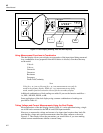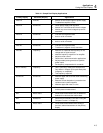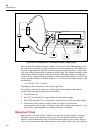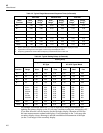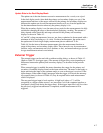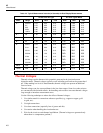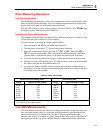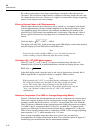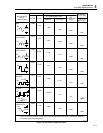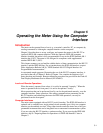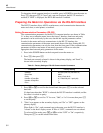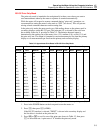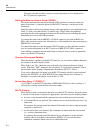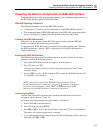
45
Users Manual
4-10
By contrast, many meters use average-responding ac converters rather than true rms
converters. The scale factor in these meters is adjusted so that they display the rms value
for a harmonic-free sine wave. However, if a signal is not sinusoidal, average-responding
meters do not display correct rms readings.
Effects of Internal Noise in AC Measurements
With the input shorted in an ac function (volts ac, current ac, or frequency) the display
will read approximately 50 due to internal amplifier noise. Because the meter is a true
rms responding meter, this noise has only minimal contribution to the reading at the
specified floor (1500 counts in the medium rate) of each range. When the rms value of
the two signals (internal noise and range floor) is calculated, the effect of the noise is
shown:
Total rms digits =
8.1500)150050(
22
=+
The display will read 1501. At the down-range point (2800 display counts in the medium
rate), the display will read 2800 with no observable error.
Note
Do not use the relative modifier (REL) to "zero" the meter because the
relative reading is simply subtracted from the present reading.
Calculated (AC + DC) RMS Measurements
When Y and Z, or C and D are pressed simultaneously, the meter will
alternately take a dc and an ac measurement then calculate and display the rms value:
RMS value =
22
acdc +
In the dual display mode, when the volts ac and volts dc functions are selected, the 10
MΩ dc input divider is in parallel with the ac-coupled 1 MΩ ac divider.
Note
When measuring AC + DC, (or any dual display combination of AC and
DC) In the fast reading rate, the Fluke 45 may show significant reading
errors. This results from a lack of filtering on the DC portion of the
measurement for the fast reading rate. To avoid this problem, use only the
"slow" and "medium" reading rates for AC + DC or AC and DC
combinations.
Waveform Comparison (True RMS vs. Average-Responding Meters)
Figure 4-3 illustrates the relationship between ac and dc components for common wave-
forms, and compares readings for true rms meters and average-responding meters. For
example, consider the first waveform, a 1.41421 V (zero-to-peak) sine wave. Both the
Fluke 45 and rms-calibrated average-responding meters display the correct rms reading
of 1.0000 V (the dc component equals 0). However, consider the 2 V (peak-to-peak)
square wave. Both types of meter correctly measure the dc component (0 V), but your
Fluke 45 also correctly measures the ac component (1.0000 V). The average-responding
meter measures 1.111 V, which amounts to an 11 % error.
Since average-responding meters have been in use for so long, you may have
accumulated test or reference data based on them. The conversion factors in Figure 4-3
should help you convert between the two measurement methods.



